From carbon ambition to delivery
It is not surprising that many CEOs feel overwhelmed as they face the climate challenge. There is no shortage of headlines highlighting the trillions of US dollars it will take to green the economy. And the opportunities are endless, with possibilities to exponentially grow customer demand for green products.
Yet the day-to-day work of turning ambition into reality is undeniably challenging. Consider that 31 per cent of companies missed scope 1 and 2 targets they set for 2020 through the Science Based Targets initiative, despite the fact that these emissions are the most controllable and there are many options available to address them (see figure).
Of course, all of this is not happening in a green vacuum. Executives are trying to pursue their decarbonisation targets during a period of turbulence that has created historic levels of uncertainty and numerous difficulties.
To translate ambition into delivery, leaders will need to adopt a mindset that we call visionary pragmatism. Organisations that meet their decarbonisation goals bring dreamers and doers on the executive team together to get five things right.
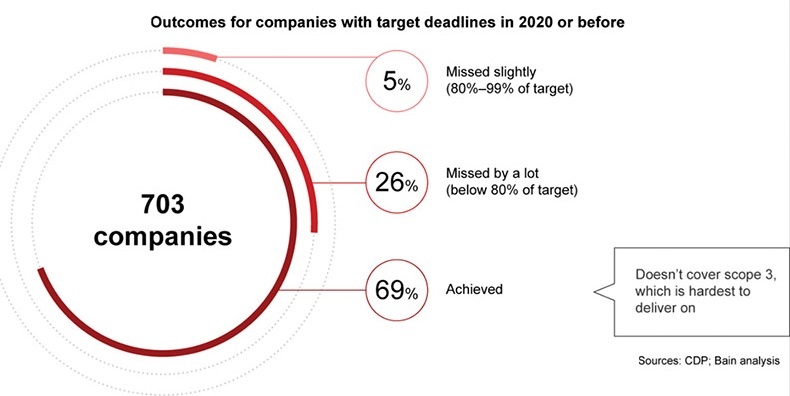 |
Put premium on strategic adaptability
Companies do not need more climate scenarios but, rather, clarity on the relevant ones. They also need to watch the signposts that will indicate what is coming next, especially regulations and advances in technology.
The best companies will embrace an adaptable approach to strategy. For example, instead of viewing it as a five-year exercise with some additional yearly refreshes, winners proactively drive the delivery agenda (what has been committed and needs to be delivered) and the development agenda (what needs to be advanced).
Address investor dissonance
Investors, as well as lenders, are increasingly assertive and discerning about decarbonisation expectations. At the same time, they may not be willing to compromise on near-term returns. There is often a dissonance between a company’s green ambitions and its growth and return aspirations, and often a perception that there will be trade-offs. Many capital markets day events have become longer, but not clearer.
Executives need to strengthen the investor dialogue. That means focusing on strategic clarity, with both concrete near-term plans to achieve decarbonisation commitments and pathways to net zero. Companies need to demonstrate progress in everything from scope 1 and 2 decarbonisation to customer collaboration on green products and meaningful portfolio shifts.
Decarbonise customer-back
In many sectors, the bulk of emissions happens when customers use the products that companies sell (downstream scope 3 emissions). In addition, what the customer wants deeply impacts embedded emissions generated during production and in the supply chain. Companies that are most successful in their climate transitions start decarbonisation with the customer in mind and work backwards across offerings, operations, and the supply chain.
Visionary pragmatists will know how to promote their green credentials and innovate with customers toward a lower-carbon, circular world. Decarbonisation will have very clear implications for how products are designed and used. Many executives view scope 3 with trepidation, but it can provide the most powerful opportunities.
Collaborate where it matters
Carbon transition is a problem far too big to be solved by any company on its own, and the need to engage the wider ecosystem of customers, suppliers, peers, governments, and civil society is increasing. Executives must decide where to collaborate as opposed to compete, picking the partnerships that can make a difference. They should forge those partnerships across the value chain, or with peers, to reach a critical mass for change.
It is quite important not to lose precious time on initiatives where there is much talk but little action. Instead, it should be aimed to ruthlessly deliver results with a clear intent for the partnership, and with early proof points gained through experimentation.
Create middle management heroes
Top management usually is fully convinced of the need for aggressive decarbonisation, given interactions with investors, the board, and key customers. New recruits often have chosen an employer based on its green credentials. Yet companies may lack committed middle management to get the job done. Too often, middle managers get bogged down when required to deliver key performance indicators on top of those for revenues and more.
How can they become net-zero heroes? The only way to create effective green middle management is to be extremely clear about which decisions to make differently and how to resolve trade-offs. The organisation needs to be trained, guided, and aligned to embed its goals as realistic deliverables.
As an example, procurement is critical to address scope 3 emissions. Managers who have been trained for years to focus on optimising cost for given specifications need clear guidance on how to reflect carbon in procurement decisions, next to specs and price, plus the tools to pragmatically assess where in the supply chain to push.
The whole organisation needs to be upskilled, though not to the same level or the same purpose. That starts by investing to understand who is most impacted and needs the most training, and then rolling out support accordingly.n
* Dale Hardcastle and Gerry Mattios are partners and directors at Bain & Company’s Global Sustainability Innovation Center in Singapore. Jenny Davis-Peccoud is partner and co-founder of Bain & Company’s global Sustainability & Responsibility practice in Amsterdam. Torsten Lichtenau is based in London and leads Bain & Company’s Carbon Transition Impact Area.
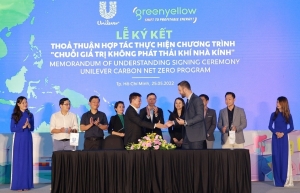 | Unilever Vietnam achieves net zero emissions nine years earlier than planned Switching to clean energy sources, reducing emissions from electricity consumption, and building green facilities are Unilever Vietnam’s efforts to obtain net zero operational emissions, underpinning the company’s commitment to achieve net zero carbon emissions throughout the value chain. |
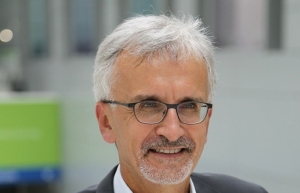 | Can Vietnam achieve its goals on net-zero emissions? Vietnam’s economic achievements have been impressive over recent decades but greenhouse gas emissions have risen alongside them. Patrick Lenain, former assistant director at the Organisation for Economic Co-operation and Development, looks at the carbon market for this country moving forward as it tries to meet major emission-reducing targets. |
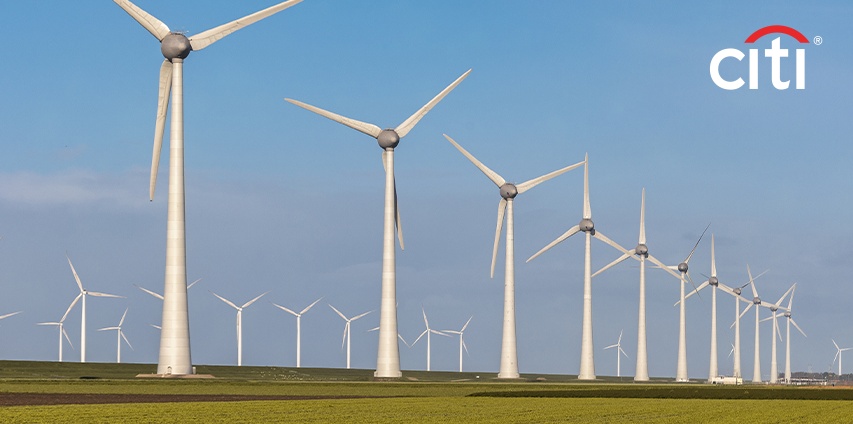 | Citi works towards sustainability and client support in Vietnam Citi global head of Social Finance Jorge Rubio and Citi Asia Pacific head of Sustainability and Corporate Transitions Rapheal Erasmus recently made working visits to Vietnam. |
 | How F1 is helping Vietnam strive for a sustainable future Recent interviews with F1 technical director Pat Symmonds and F1 managing director Ross Brawn now reveal the next step that F1 is going to take towards its sustainable future: developing a fully sustainable fuel solution based on biomass fuel for 2026, alongside global sponsor ARAMCO. |
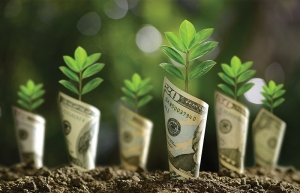 | New finance instruments in play for climate future Given the current status, a novel public development bank or energy-focused financial vehicle could support Vietnam to realise its goal of transitioning to a low-carbon, climate-resilient economy in an equitable manner. |
What the stars mean:
★ Poor ★ ★ Promising ★★★ Good ★★★★ Very good ★★★★★ Exceptional
 Tag:
Tag:
Related Contents
Latest News
More News
- Businesses ramp up production as year-end orders surge (December 30, 2025 | 10:05)
- Vietjet chairwoman awarded Labour Hero title (December 29, 2025 | 13:06)
- How to unlock ESG value through green innovation (December 29, 2025 | 10:03)
- AI reshapes media and advertising industry (December 29, 2025 | 08:33)
- FPT and GELEX sign deal to develop blockchain tech for global markets (December 29, 2025 | 08:29)
- Vietnam’s GDP forecast to grow by 9 per cent in 2026 (December 29, 2025 | 08:29)
- Women entrepreneurs are key to Vietnam’s economic growth (December 29, 2025 | 08:00)
- Vietnam's top 500 value-creating enterprises announced (December 27, 2025 | 08:00)
- The PAN Group shaping a better future with ESG strategy (December 26, 2025 | 09:00)
- Masan Consumer officially lists on HSX, marking the next phase of value creation (December 25, 2025 | 13:20)





















 Mobile Version
Mobile Version